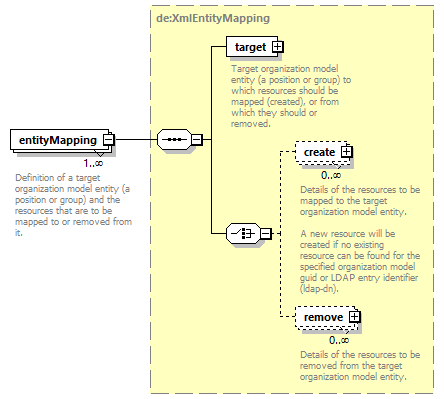| diagram |  |
||
| namespace | http://mapping.api.de.n2.tibco.com | ||
| properties |
|
||
| children | entityMapping | ||
| annotation |
|
||
| source | <xs:element name="mapEntities"> <xs:annotation> <xs:documentation>Request element for mapEntities operation. This service will assign, or remove, resources to, or from, identified positions and/or groups - creating those resources if necessary. Each entityMapping element identifies a position or group and the resouces that are to be added to or removed from that entity. The position or group is identified by its entity-type, guid and model version. If no model version is specified (or -1 is given), the version with the greatest major value is used. When adding a resource to an entity, the "create" element will identify an existing resource by its GUID, or provide the LDAP details necessary to create a new resource. Those LDAP details include the LDAP container identifier (its "id") and the alias and DN, for each LDAP source within that container, from which the resource will be derived. The name attribute within each "create" element specifies the name to be assigned to a newly created resource - it is ignored if the resource already exists. Each "create" element may also specify a date-range for which the assignment is to apply. By including a "remove" and "create" element for the same resource, the assignment's date-range can be adjusted. The "invalid" and "invalidReason" of the "create" element are not used in the request. These are used in the response to indicate any reason why the resource would cause a conflict with existing resources.</xs:documentation> </xs:annotation> <xs:complexType> <xs:sequence> <xs:element name="entityMapping" type="de:XmlEntityMapping" maxOccurs="unbounded"> <xs:annotation> <xs:documentation>Definition of a target organization model entity (a position or group) and the resources that are to be mapped to or removed from it.</xs:documentation> </xs:annotation> </xs:element> </xs:sequence> </xs:complexType> </xs:element> |
element mapEntities/entityMapping
| diagram |  |
||||||
| type | XmlEntityMapping | ||||||
| properties |
|
||||||
| children | target create remove | ||||||
| annotation |
|
||||||
| source | <xs:element name="entityMapping" type="de:XmlEntityMapping" maxOccurs="unbounded"> <xs:annotation> <xs:documentation>Definition of a target organization model entity (a position or group) and the resources that are to be mapped to or removed from it.</xs:documentation> </xs:annotation> </xs:element> |
WSDL documentation generated by XMLSpy WSDL Editor http://www.altova.com/xmlspy